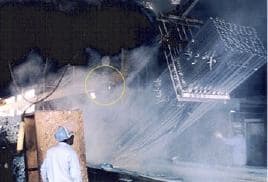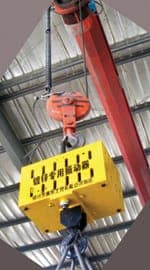
Curated with aloha by
Ted Mooney, P.E. RET

The authoritative public forum
for Metal Finishing 1989-2025

-----
Galvanizing with Vibrator on the Crane Lift?
August 19, 2011
Good morning (or evening depending on where you are!)
I am currently a maintenance supervisor at a galvanizing plant in Texas. Doing research on various pieces of equipment I came across this machine called VibraHoist (www.navco.org/other-vibrators/vibrahoist.html)

(photo added 9/12/11)
It claims to help reduce zinc usage and labor by reducing required cleaning of the finished product.
My question is, does anyone have any experience(s) (good or bad) using this product or anything like it?
Thank you for your time!
-Keith
Maintenance Supervisor, Galvanizing - Waskom, Texas, USA
Hi, Keith. I've always wondered if anyone had tried such an approach on an electroplating line, too, because each drop of dragout requires expensive wastewater treatment and sludge disposal. If anyone has experience or comments on the proposition of vibrators on the material handling equipment, they are welcomed!
We don't do background checks on the responders or even require registration; this allows fictitious testimonials & slams from people with vested interests. For that reason and others, we don't post appraisals of specific brands.
Regards,

Ted Mooney, P.E.
Striving to live Aloha
finishing.com - Pine Beach, New Jersey
August 19, 2011
Hi Ted,
Thanks for the reply.
Like you I'm interested the process itself (that of vibrating a load as it is lifted out of the kettle to remove excess zinc and help prevent icicles, etc.) not that particular brand. I can't find anyone that uses something like this or that even knows of anyone else using something like this. I'm hoping someone here maybe has used this procedure.
Thanks again for taking my question!
-Keith
- Waskom, Texas, USA
August 20, 2011
August 26, 2011
Sir:
In the old English literature there is an article about vibrating window frames. That article concludes that a low frequency and high amplitude vibration causes 14% less zinc to be on the product. Using high frequency and low amplitude caused MORE zinc to be on the product, because this causes standing waves of zinc on the product which freeze.
In Canada I literally stumbled over a vibrating device on the floor of the galvanizing plant. I think it had a car spring in it and I believe a circular cage in which a heavy steel ball was blown in a circle via an air line. Thinking the use of this vibrator was to shake the product as it was withdrawn from the molten zinc, I asked the owner how well it worked. He told me that he did NOT use it in that way. Rather he used the vibrator on heavy section product IN the kettle to cause thermal equilibrium to occur sooner. Thus on heavy section steel he could attain only 10 minutes in the zinc rather than 20 minutes in the zinc. Since it was on the floor at the kettle I assume that he did use it on occasion for the purpose that he stated.
I further asked him if he EVER used it while withdrawing the steel from the zinc and he said "NO," because with heavy loads it shook his crane too much. His answers surprised me.
Again low frequency and high amplitude is required, like striking individual product with heavy impact.
Regards,
Galvanizing Consultant - Hot Springs, South Dakota, USA
Dr. Cook:
I greatly appreciate you taking the time to reply. The idea of using it on product in the kettle for "thermal equilibrium" is extremely interesting.
As for "shaking his crane too much" it sounds like he was using an in-house built vibrator without any dampeners or anything installed to prevent the vibrations from traveling back up to the hoist. Assuming you had something that prevented return vibration up to the hoist, do you think it would be worth trying to shake excess zinc off product?
The primary application I was thinking of using it for was universal racks that hold dozens and dozens of smaller pieces spaced inches apart.
Again, thank you for the reply.
- Waskom, Texas, USA
August 31, 2011
September 1, 2011
Sir:
In my faint distant memories other galvanizers had told me that with heavy lifts the usual item that shakes is the crane. I believe this simply has to do with the mass of the crane (being smaller) than that of the product. The "vibrator" must be capable of low frequency and high amplitude. Obviously anything is worth a try, but as you have observed there just does not seem to be anybody doing it.
Whatever you decide to do or not do. Be sure to not mess up your crane. And if possible give results on this site (good or bad). To dampen vibrations to the crane, perhaps you could use a "bungee" cord. Frankly I just do not see a way to prevent crane vibrations. For example if the crane is 1/10 the mass of the product load, then the energy vibration in the crane should be ten times that in the product.
Regards,
Galvanizing Consultant - Hot Springs, South Dakota, USA
I did some experimentation with such a device once, and while crane vibration was one issue, probably resolvable, it was the galv finish that "finished" this idea.
The surface of the zinc is continually oxidizing, so movement of the steel pieces, horizontally will cause them to pick up more zinc oxide scum, and this creates poor finish.
There was some reduction of zinc drips (spikes, run off that freezes etc), but overall not a success.
I've seen various forms of devices in some plants, and have never seen one in regular use. I have found several people using them as dross vibrators, shaking the dross removal device to allow free zinc to flow out and separate.

Geoff Crowley
Crithwood Ltd.
Westfield, Scotland, UK

First of three simultaneous responses -- September 3, 2011
Second of three simultaneous responses -- September 6, 2011
Dr. Cook,
Again I thank you for your time and reply. I will definitely post back if we attempt this in the future.
Good day,
Keith
- Waskom, Texas
I have seen a Vibrator with spring attachment, to prevent the vibration to reach the crane and damage the shed, fixed to the EOT crane . As soon as the materials are taken out of the galvanizing Bath, the vibrator is put on and it shakes the galvanized materials thereby the excess drainage Zinc is recovered in the Bath and the finishing/removal of excess zinc manually is eliminated. These vibrators are available in China. Some galvanizers also put on the vibrators after immersion of steel in galv. bath and the vibration helps in accelerating the galvanizing time.
Hemant Khaitan- Kolkata, India
Third of three simultaneous responses -- September 6, 2011
September 6, 2011
Hermant,
The guy in Texas has a 42 ft long by 7 ft wide by 7 ft deep kettle and it is likely he uses universal racks with very heavy steel product. Is it likely that the vibrator you described could vibrate his steel with low frequency and high amplitude to shake off excess zinc without damage to the crane? Could you post a diagram on how vibration of the crane is prevented?
Why am I not surprised that the vibrator is available in China?
Do these same galvanizers use the mentioned vibrator to vibrate the dross scoop (shovel) during drossing?
Regards,
Galvanizing Consultant - Hot Springs, South Dakota, USA
September 7, 2011
Sirs:
From this thread I am getting some ideas. I now have galvanizing processes in which the ash does NOT stick to the steel. Thus vibration in the correct direction might actually work. If the vibrator is attached between the crane and the product, the only vibration could be vertical and thus damage the crane. If the vibrator were attached to a fixed post then vibration could be horizontal. I would also think that vibration perhaps should only occur after full withdrawal of the product. In my processes an extremely important point is "SKIM-ABILITY" (which is that the molten zinc surface remains liquid and does not cloud or ash over).
Strange how a thread can cause a person to think and invent.
Regards,
Galvanizing Consultant - Hot Springs, South Dakota, USA
September 8, 2011
Sir:
I just spoke with a production manager in a galvanizing plant on another issue, but mentioned vibration to shake off excess zinc. His comment was that it destroyed hoist cables or chains and he had to replace them very often. He had to convince the owners that the vibrator was not a good idea.
I am "day-dreaming" ideas to bump/thump the product to get the required results.
Regards, Dr. Thomas H. Cook, Hot Springs, South Dakota, USA
Galvanizing Consultant - Hot Springs, South Dakota, USA
What about a weighted pendulum spinning around on the X/Y axis (inside a housing of course), nothing moving on the Z axis, to create the horizontal vibration? I'm not sure if this would provide enough vibration to remove the excess zinc though.
I'm kind of picturing someone with a hula hoop, a motion like that.
- Waskom, Texas, USA
September 9, 2011
September 12, 2011
Dear Dr, Cook,
Sorry for delay in response as I was travelling. I have seen the vibrator operate in a plant in Malaysia. Since the vibrator is attached at one end (which is taken out last from the pot) only , the length of the materials is not an issue. The weight of the galvanized articles was approx. 2 MT and I guess higher capacity vibrators are also available. The vibrator is attached on a Steel plate with springs attached so that the vibration is only transferred vertically in the down direction and not up towards the crane. The name of Chinese company manufacturing it is Xinyue. Apart from excess zinc removal it might help in shaking the ash as well.

Regards
- Kolkata, India
Dear Dr Cook,
have you been able to study this vibrator and if so your comments on how to use it for maximum benefit. thanks
- Kolkata, India
October 28, 2011
Q, A, or Comment on THIS thread -or- Start a NEW Thread